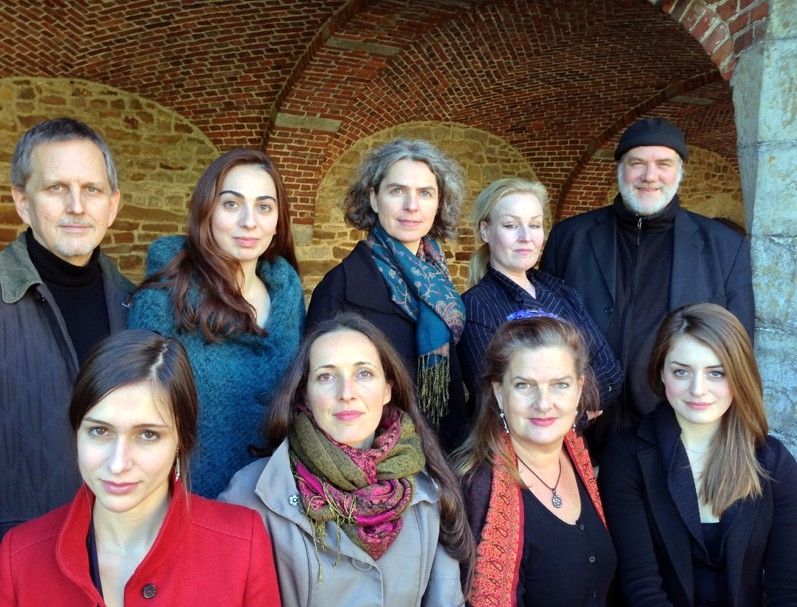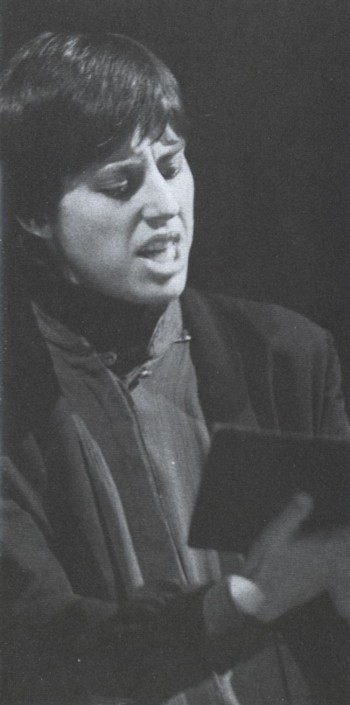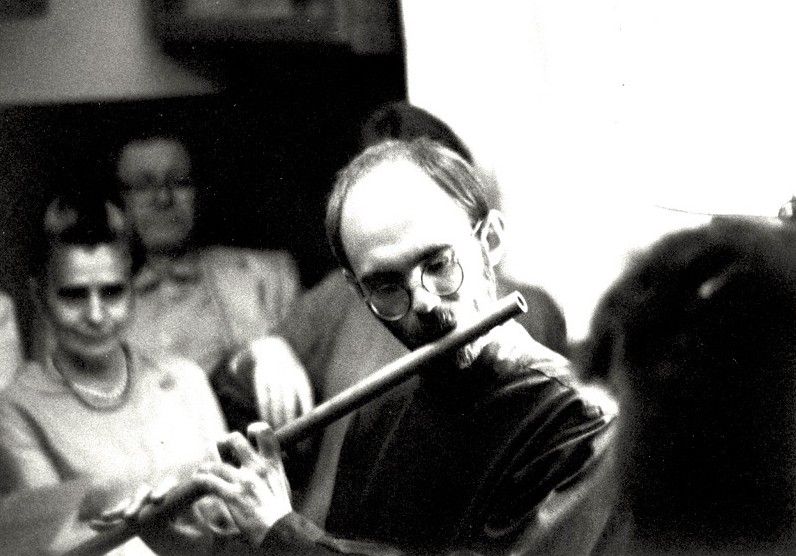
medieval.org
sequentia.org
Deutsche Harmonia Mundi 8 87654 68642 8
2013
1. O splendidissima gemma [10:21]
V fol. 154 · antiphon, to Maria / with canticum: Magnificat anima mea dominum
Lena Susanne Norin, ensemble
2. O dulcis electe [4:34]
V fol. 161v · responsory, to St. John the Evangelist
Sabine Lutzenberger, ensemble
3. O speculum columbe [7:34]
V 161v · antiphon, to St. John the Evangelist / with Gloria patri
Lydia Brotherton, with Norbert Rodenkirchen flute, ensemble
4. O spectabiles viri [5:34]
V fol. 159v · antiphon, to the Patriarchs and Prophets
Christine Mothes, ensemble
5. O cohors milicie floris [13:45]
V fol. 160v · antiphon, to the Apostles
with canticum: Benedictus Dominus Deus Israel
Agnethe Christensen, ensemble
6. O victoriosissimi triumphatores [8:29]
V fol. 163 · antiphon, to the Martyrs / with: Gloria patri
Lena Susanne Norin, with Benjamin Bagby harp, ensemble
7. Kyrieleison [3:13]
R fol. 472v
Esther Labourdette, ensemble
8. O vos imitatores excelse [4:23]
V fol. 163v · responsory, to the Confessors
Sabine Lutzenberger, ensemble
9. O gloriosissimi lux [5:12]
V fol. 159 · antiphon, to the Angels
Elodie Mourot, ensemble
10. O vos angeli [8:40]
V fol. 159 · responsory, to the Angels
Lena Susanne Norin, Sabine Lutzenberger, Agnethe Christensen (verse),
Lydia Brotherton, Norbert Rodenkirchen flute, ensemble.

The Sequentia women's vocal ensemble:
Lydia Brotherton
Agnethe Christensen
Esther Labourdette
Sabine Lutzenberger
Christine Mothes
Elodie Mourot
Lena Susanne Norin
Instrumentalists:
Norbert Rodenkirchen, flutes
Benjamin Babby, harp
SEQUENTIA, Ensemble for medieval music
BENJAMIN BAGBY, director
Sources:
All performing editions were prepared by Benjamin Bagby and are based on the manuscript V:
Dendermonde (Belgium), St. Pieter Et Paulusabdij Codex Afflighemiensis 9 (Rupertsberg, ca. 1170).
The Kyrieleison (track 7) and some minor corrections are from the manuscript R: Wiesbaden, Hessische Landesbibliothek, Hs. 2 ('Riesenkodex'). One small correction in O vos imitatores (track 8) is taken from Z: Stuttgart, Württembergische Landesbibliothek, Codex theol. phil. 4° 253 (fol. 40v).
Instruments:
- transverse flute (track 3) by S. Silverstein (New York City, 1980)
Note: this instrument once belonged to David Hart (1951-1988) who played it in the first two Sequentia recordings of Hildegard's music.
In 2012 the flute was given to Norbert Rodenkirchen by David's brother Jim Hart, and is played here again, 30 years later.
- 15-string harp (track 6) by Geoff Ralph (London, 1983)
- transverse flute (track 10) by Neidhart Bousset (Berlin, 1998)
Recording: November 11-15, 2012, Church of Saint Remigius, Franc-Waret, Belgium
Recording Producer and Engineer: Nicolas Bartholomée · Assistant Engineer: Maximilien Ciup
Production Assistance: Norbert Rodenkirchen · Associate Producer: Matthias Spindler. Executive Producer: Jon Aaron
Front cover: The angelic choirs, from Hildegard's Scivias, Wiesbaden, Hessische Landesbibliothek Hs. 1
(lost after 1945), 20th-century parchment copy from the Abtei St. Hildegard, Eibingen (Germany); akg-images / Erich Lessing
Artwork: www.waps.net
in memoriam
BARBARA THORNTON (1950-1998)
THE HEAVENLY HIERARCHY, OR RAYS OF LIGHT
Mention the word "hierarchy" today, and very few people will respond
positively to it, for we tend to think, rather, of fossilized power
structures, of individuals straying into areas outside their field of
competence and of attempts to muzzle those who think differently. It
may be even harder for us to grasp the concept of a heavenly hierarchy
as we are likely to suspect that we are dealing here with the same
defective forms and at the same time that there is no possibility of
resisting them.
Hildegard von Bingen (1098-1179) thought very differently. If she saw
the saints and angels as an effective part of otherworldly reality, it
was because she sensed that they supported her through a network whose
scope for action far exceeded her own. And so she did what anyone would
have done who wants to achieve something and who is in full possession
of all their senses: she sought support from those people who had led
exemplary lives and who were now in the Kingdom of Heaven or, in the
case of the angels, had dwelt with God since the dawn of Creation.
SAINTS IN THE BACKGROUND
The present release is the last in the series of Sequentia's set of
recordings of music by the medieval female composer Hildegard von
Bingen and is devoted to her hymns not only to the angels but also to
the patriarchs and prophets, the apostles, martyrs, confessors, John
the Evangelist and Mary the Mother of Jesus. Hildegard felt very close
to each and every one of them, their exemplary lives encouraging her to
continue on her own often difficult and painful journey through life.
Two instances may illustrate this point. The patriarch Abraham left his
home city of Ur of the Chaldees in order to embrace an uncertain
future. In much the same way, Hildegard left the protection of the
convent at Disibodenberg to live in the wilderness of Rupertsberg far
from human comforts and achieve her dream of self-determination. The
Virgin Mary was Hildegard's point of departure in developing her own
particular brand of theology, with its support for women and for human
dignity in general, an outlook that shielded the women of her convent
from the commonplaces of the theological mainstream, which saw them as
the source of all evil.
For Hildegard, every spiritual journey began with repentance, a
world-changing force that found expression in a sigh. By "repentance"
she meant the anguish felt when we are untrue to our innermost nature.
In the case of the present recording, this aspect of Hildegard's world
view is represented by the Kyrie eleison ("Lord, have mercy
upon us"), which is an appeal to God's helping power and at the same
time a hymn in celebration of that power. Its roots can be traced back
to the Hellenistic period.
In Hildegard's eyes, praising God was one of those activities that
allow us as individuals to reconnect with our origins, when the world
was still a place of unspoilt innocence. When singing God's praises, we
too take our place in Creation and achieve a state of self-realization.
The interpretation of Creation as a musical event in which the world
comes into existence through singing and is shaped by musical sounds is
one that is found in many religions. According to Hildegard's view of
theology, the literally shining example of this creative music-making
takes the form of the angels, those beings of light whose principal
task is to praise God. All human singing takes their musical existence
as its starting point. When we add our voices to the eternal choir of
angels, we invest our lives with a whole new perspective, thinking and
acting in ways that literally transcend our limited human existence. lt
is no accident that Hildegard's responsory O vos angeli seems
to reflect the distance between heaven and earth with a range that
extends over two and a half octaves. Light and sound are closely
related phenomena, and the idea of a cosmos resounding with music is
one that was bound to appeal to the visionary Hildegard, whose visions
included not only the visible reality of God but also His musical
reality.
As Hildegard puts it in her antiphon O spectabiles viri, the
veneration of the saints begins with the patriarchs and prophets of the
Old Testament who, like her, saw the living light for themselves. (In
advancing this view, Hildegard was not only on firm theological ground
but was also documenting her own understanding of the matter.) On their
way to being examined prior to their acceptance into the tenth choir of
angels, which, as Hildegard says, human beings are called upon to form,
these ancient saints, in which the light took root, are expert
precursors preparing the journey for those who are destined to follow
them. They are succeeded by the apostles as symbolic representatives of
the twelve tribes of Israel, who herald the age of the New Testament.
In the early Church, the injunction "Be ye holy, for I am holy" applied
as a matter of course to all Christians. For Hildegard, sanctity was
above all a question of wholeness, which in terms of her own
theological outlook could mean only to be in harmony with the positive
forces of the cosmos, a harmony that in music is the equivalent of
consonance. Among those who were venerated as saints, pride of place
goes to those who died for their faith. It is to them that Hildegard
dedicated her antiphon O victoriosissimi triumphatores. Next to
the martyrs it was the confessors who were revered as saints, men and
women who attested to the truth of the Word that Christ had addressed
to them and that He Himself embodied. Hildegard honours them with her
responsory O vos imitatores excelse. In her theology, Mary and
John represent a direct link with God and His son, Jesus Christ. John
is believed to be the disciple whom Jesus loved above all others and
who remained at His side at the Last Supper. The extent to which
Hildegard identified with John is clear from a vision - arguably her
most personal - in which she herself takes his place. This connection
between the Benedictine abbess and the disciple is particularly clear
in the responsory O dulcis electe. In it she describes John as
someone who comforts the "pigmentarii", an old word that literally
means "perfumers" or "salve mixers", in other words, bishops who are
meant to be the source of viriditas, the viridescent, healing
life force that floods the whole of the cosmos.
Mary is undoubtedly Hildegard's favourite female saint, and the
antiphon O splendidissima gemma is a fine example of her
spirituality, a spirituality that links earth and heaven and that
encapsulates the poet's fascination with gemstones, which she regarded
as tangible relics of Paradise, allowing her to put into words her love
of the Virgin Mary and to clothe that love in a complex musical form. O
splendidissima gemma has been re-recorded for the present album, as
the earlier recording from 1982, in which it featured as part of the
morality play Ordo Virtutum, is no longer commercially
available.
 WHY LESS IS MORE AND WHY FAITH IS NOT A SHORTCOMING
WHY LESS IS MORE AND WHY FAITH IS NOT A SHORTCOMING
A comparison between the present release and earlier Sequentia
recordings reveals that in the present case the instrumental
accompaniment is markedly sparer, although this does not mean that
instruments were not used in Hildegard's day. Her biographer and
secretary Guibert of Gembloux mentions that her works were performed
using instruments, and she herself thought highly of flutes, harps and
other instruments, as is clear from her magnificent letter to the
prelates of Mainz in which she describes the function of music, even
identifying various human characteristics with different bodies of
sound. But there are good reasons to use instruments more sparingly
than was customary in the 1990s and to deploy them above all in the
solo antiphons, which are particularly intimate in expression. At the
same time, they may be used to lend a sense of stability to large-scale
structures such as O vos angeli. Hildegard's songs are not
examples of art music that are at home onstage and that can be arranged
in effective ways depending on the performers' inspiration and wealth
of ideas. The longer the ensemble has worked on this music and examined
the research that has been conducted on it, the more it has become
clear that we are dealing here with music for the liturgy. If we take
this idea seriously, then we shall find that our basic attitude to the
way that this music is sung and played is bound to change. Even though
we live in an age in which faith is no longer a subject of discussion
for many people, we cannot assume that this was the case in the twelfth
century. Hildegard's music is inspired by the liturgy and written for
it. If we take this into account, these works gain in focus and
radiance, qualities necessary if we are to penetrate to their core.
The same is true of their notation. In the twelfth century neumatic
notation was characterized by a different approach to the notes from
that found in earlier manuscripts. And this certainly applies to
Hildegard's compositions, which are influenced in turn by the vocal
tradition of the Rhineland. The technique that she used in adapting the
versus melodies affords impressive evidence of the care she
lavished on the word-tone relationship, while her use of liquescent
neumes for semantic purposes points to the rhythmic information
contained in the neumatic notation of late Gregorian chant both in her
own compositions and in those of a number of her contemporaries. If we
take this seriously, the texts and their living declamation again
become the focus of attention, and the melodies are taken seriously as
a way of deepening and interpreting the textual message. This is
perhaps their principal advance on equal or mensural interpretation.
Taking account of the contextuality of Hildegard's settings, Benjamin
Bagby and his ensemble have deliberately combined a number of them with
a Gloria Patri, a Magnificat and a Benedictus,
since these antiphons were intended to be used during the canticles at
lauds and vespers. It is merely because of the limits on the time
available that not all the songs have been combined with Psalm verses
and a Gloria Patri. As the basis of its recording the ensemble
used the Dendermonde Codex, which dates from around 1170 and is the
older of the two manuscripts preserving Hildegard's songs. The later
Kyrie is taken from the so-called Riesenkodex. I am
particularly delighted at this release as it provides a magnificent
conclusion to Sequentia's pioneering complete recording. And I am no
less grateful for my long and invariably inspiring contact with
Benjamin Bagby and the unforgotten Barbara Thornton, whose ideas,
profound musicality, expertise and enthusiasm substantially enriched my
own work on these pieces.
Translation: Stewart Spencer
THE HILDEGARD VON BINGEN PROJECT (1982-2012)
Since the early 1980's, the ensemble Sequentia's name has been closely
linked with the music of Hildegard von Bingen, the visionary abbess
whose musical compositions are among the most astonishing and unique
creations from the dynamic milieu of 12th-century Benedictine
monasticism. Under the general artistic direction of the late Barbara
Thornton, many of the world's foremost vocalists and instrumentalists
active in historical music performance joined Sequentia to perform and
record Hildegard's works on a regular basis between 1982 and 1999, and
again under Benjamin Bagby's direction in 2012.
In 2012 this final recording of the complete works, Celestial
Hierarchy was brought to life by Sequentia's co-founder and
director Benjamin Bagby to commemorate the elevation of Hildegard von
Bingen to Sainthood and Doctor Ecclesiae (2012), to finish Sequentia's
complete works project on the DHM label, and thus to honour the life's
work of Barbara Thornton. For this recording, a multi-generational
ensemble of seven women's voices has been assembled under Bagby's
direction, together with the flautist Norbert Rodenkirchen and Bagby
playing harp. One of the singers on this final recording had been a
member of Barbara Thornton's ensemble, while some others were not yet
born when the first recording was made in 1982.
THANKS
to HERMAN BAETEN (Musica, Belgium) for the facsimiles of the
Dendermonde manuscript (Alamire publishers) generously given to each
musician involved in this project.
to MARIE NOEL COLETTE for stimulating discussions about 12th-century
chant notation, especially the quilisma.
to JIM HART for the gift of David Hart's flute, used here in track 3.
to LAURENCE MOULINIER for permission to use her French translations of
Hildegard's texts.
to KATARINA LIVLJANIC for providing the psalm-tones and cantica-tones
used in this recording.
to LAWRENCE ROSENWALD for his new English translations of Hildegard's
texts.
to BARBARA STÜHLMEYER for permission to use her German
translations of Hildegard's texts and for her many years of support of
the ensemble's Hildegard project.
